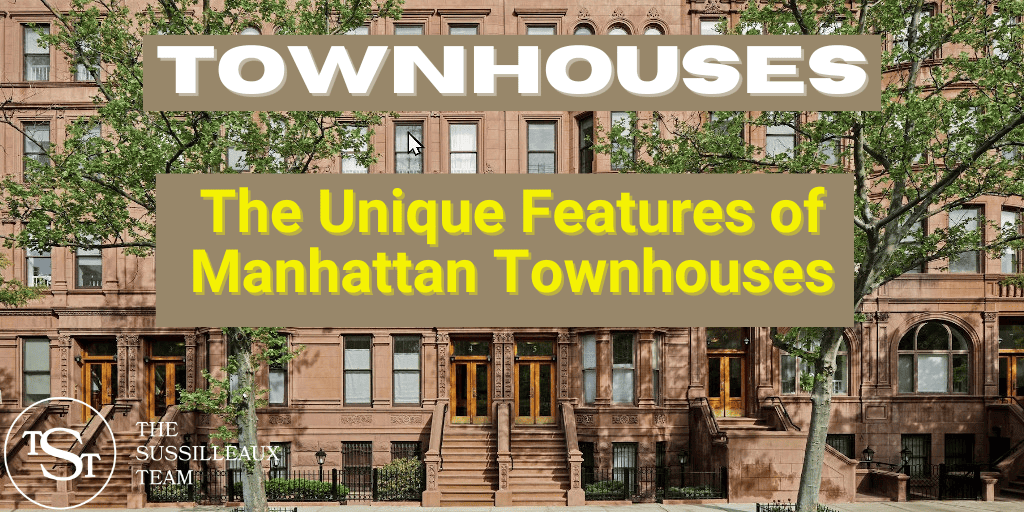What are the Unique Features of Manhattan Townhouses?
The unique features of Manhattan townhouses include their diverse architectural styles, spacious interiors, private outdoor spaces, architectural details, and the potential for customization, providing residents with a distinctive and elegant living experience in the heart of New York City.
Another distinctive feature that appeals to many of our townhouse clients is the concept of a private residence among the multi-family dwellings that make up the bulk of New York City residential real estate.
A Brief History of Manhattan Townhouses
In our over 40 years of combined experience, Dina and I remain fascinated by the history and evolution of townhouses in New York City. Our clients are interested too, and often pick our brains to find out more.
With this client interest in mind, and based on our experience and expertise, we’ve put together this brief overview of Manhattan townhouse history for you. Feel free to have a chat with us at any time to learn more. Contact Michael and Dina Sussilleaux
Early Beginnings and Influences
Manhattan townhouses have a rich history dating back to the early Dutch settlements in the 17th century. As New Amsterdam transitioned to New York under British rule, the architectural style of the townhouses evolved, influenced by European trends. These early residences were simple in design, with modest facades and practical layouts.
Key Periods and Architectural Styles
Throughout the 18th and 19th centuries, Manhattan townhouses developed into more elaborate and ornate structures, reflecting the growing wealth and prestige of New York City. Key architectural styles include the Federal, Greek Revival, Italianate, Second Empire, and Romanesque Revival styles. The iconic brownstone facade became popular during the mid-19th century, giving rise to the term “brownstone” as a synonym for a Manhattan townhouse.
Exterior Features of Manhattan Townhouses
Facades and Building Materials
Brownstone, Limestone, and Brick
Manhattan townhouses feature various facade materials, with brownstone, limestone, and brick being the most common. Brownstone, a reddish-brown sandstone, was favored for its durability and ease of carving, while limestone and brick provided a more elegant appearance. The choice of building material often reflects the architectural style and period of construction.
Signature Architectural Details
Each architectural style is characterized by unique exterior details. Federal-style townhouses often feature decorative lintels and elliptical fanlights, while Greek Revival homes boast heavy cornices and columned entrances. Italianate townhouses are adorned with ornate window moldings, and Romanesque Revival buildings showcase round-arched windows and doors.
Entrances, Stoops, and Doorways
The Role of Stoops
The stoop is an iconic feature of Manhattan townhouses, serving both a practical and social purpose. Elevated above street level, the stoop provides privacy and security for the home’s occupants. Additionally, stoops were historically a gathering place for neighbors to socialize and interact.
Doorway Designs and Ornamentation
Manhattan townhouse entrances are often embellished with decorative details such as transom windows, sidelights, and carved moldings. Doorway designs vary by architectural style, with Greek Revival homes featuring columned porticos and Romanesque Revival residences showcasing elaborate stone carvings.
Ironwork, Railings, and Fences
Intricate ironwork, railings, and fences are common exterior features of Manhattan townhouses. These elements not only provide safety and security but also add visual interest and elegance to the facade. Decorative ironwork designs often reflect the architectural style of the building.
Windows and Cornices
Manhattan townhouses showcase a variety of window styles, including floor-to-ceiling windows, bay windows, and arched windows, depending on the architectural style. Ornate cornices, often made from cast iron or carved stone, add a finishing touch to the exterior design.
Interior Features of Manhattan Townhouses
Layout and Floor Plans
Parlor Floors and Bedroom Levels
Manhattan townhouses typically feature a multi-story layout, with distinct levels designated for specific functions. The parlor floor, often the most ornate and grand, was reserved for formal entertaining, while upper levels housed bedrooms and private living spaces.
Garden Level: Kitchens and Staff Quarters
Historically, kitchens, dining rooms, and staff quarters were located on separate levels or at the rear of the home, reflecting the social hierarchy of the period. In modern renovations, kitchens and dining areas are often integrated into open-concept living spaces for a more contemporary feel.
High Ceilings and Crown Molding
High ceilings are a signature feature of Manhattan townhouses, contributing to a sense of grandeur and spaciousness. Crown molding, adorned with intricate designs, adds elegance and sophistication to these homes.
Staircases and Balustrades
Central staircases in Manhattan townhouses serve as both functional and decorative elements, with elaborate balustrades and handrails showcasing the craftsmanship of the period. Staircases often feature carved newel posts and ornate iron or woodwork.
Fireplaces and Mantels
Fireplaces are a common feature in Manhattan townhouses, often serving as a focal point in living and dining rooms. Fireplace and mantel designs vary according to the architectural style, with marble, carved wood, and cast iron used to create unique and eye-catching centerpieces.
Unique Architectural Details
Manhattan townhouses often include distinctive interior details that reflect the architectural style of the building. Examples include decorative plasterwork, intricate wood paneling, stained glass windows, and elaborate ceiling medallions.
Outdoor Spaces and Gardens
Rear Yards and Gardens
Many Manhattan townhouses feature rear yards and gardens, providing a private oasis in the heart of the city. These outdoor spaces can be landscaped with lush plantings, fountains, and seating areas, offering a tranquil retreat for relaxation and entertaining.
Rooftop Gardens and Terraces
Rooftop gardens and terraces are a modern adaptation of Manhattan townhouses, capitalizing on the limited outdoor space in the city. These elevated outdoor areas offer panoramic views of the cityscape and can be outfitted with dining and lounging furniture, creating an urban sanctuary.
Balconies, Terraces, and Juliet Balconies
Some Manhattan townhouses feature balconies or Juliet balconies, providing additional outdoor space and architectural interest. These small exterior platforms are often accessible from upper-level bedrooms or living spaces, allowing for fresh air and city views.
Terraces are often built on the roof of building extensions, providing even more outdoor space.
Modern Adaptations of Manhattan Townhouses
HRenovations and Restorations
Preserving Original Features
Modern renovations of Manhattan townhouses often aim to preserve original architectural features while incorporating contemporary amenities. This delicate balance between old and new can be achieved through careful planning, working with skilled architects, and selecting complementary materials and finishes.
Integrating Modern Amenities
Today’s homeowners appreciate the historic charm of Manhattan townhouses but also desire modern conveniences. Renovated townhouses often feature state-of-the-art kitchens, luxurious bathrooms, and energy-efficient systems, seamlessly blending traditional and contemporary elements.
Sustainable and Eco-friendly Solutions
Green Roofs and Solar Panels
As sustainability becomes increasingly important, some Manhattan townhouse owners are incorporating eco-friendly solutions into their renovations. Green roofs, which feature vegetation and soil, help reduce stormwater runoff, improve insulation, and support urban biodiversity. Solar panels can be installed to harness renewable energy, further enhancing the home’s environmental footprint.
Energy-efficient Systems
Upgrading to energy-efficient systems, such as heating, cooling, and lighting, is another way to improve the sustainability of a Manhattan townhouse. These modern systems not only reduce energy consumption but also contribute to lower utility bills and improved indoor comfort.
Conclusion
The unique features of Manhattan townhouses, including their rich history, architectural details, and outdoor spaces, contribute to their enduring appeal and desirability as real estate investments. By preserving the original charm of these historic homes and adapting them for modern living, homeowners can enjoy a luxurious, one-of-a-kind living experience in the heart of New York City.
Further Reading
You can return to The Complete Guide to Manhattan Townhouses, or view the previous article: Why Manhattan Townhouses are Highly Desirable Real Estate, or read the next article in the series: How to Find the Perfect Manhattan Townhouse for Your Needs
Frequently Asked Questions (FAQs)
- What is the difference between a townhouse and a brownstone?
- How can I identify the architectural style of a Manhattan townhouse?
- Are Manhattan townhouses typically energy-efficient, or do they require upgrades?
- What should I consider when restoring or renovating a Manhattan townhouse?
- What are some examples of modern adaptations in renovated Manhattan townhouses?
What is the difference between a townhouse and a brownstone?
A Townhouse is a term used to describe a multi-story, multifamily or single-family residence in New York City, while a brownstone specifically refers to a townhouse with a facade made of brownstone, a reddish-brown sandstone. Brownstone townhouses are a subset of Manhattan townhouses, characterized by their distinctive facade material.
How can I identify the architectural style of a Manhattan townhouse?
To identify the architectural style of a Manhattan townhouse, look for key exterior features such as the facade material, window shapes, entrance design, and decorative elements. Each architectural style has its own distinct characteristics, and understanding these can help you determine the style of a particular townhouse.
Are Manhattan townhouses typically energy-efficient, or do they require upgrades?
Historic Manhattan townhouses may not be energy-efficient by modern standards, often requiring upgrades to improve their energy performance. Renovations can include adding insulation, upgrading heating and cooling systems, installing energy-efficient windows, and incorporating sustainable technologies such as solar panels or green roofs.
What should I consider when restoring or renovating a Manhattan townhouse?
When restoring or renovating a Manhattan townhouse, it’s important to consider the building’s architectural style, historic significance, and structural integrity. Work with experienced architects and contractors who specialize in historic preservation to ensure that original features are maintained while integrating modern amenities and eco-friendly solutions.
What are some examples of modern adaptations in renovated Manhattan townhouses?
Modern adaptations in renovated Manhattan townhouses may include open-concept living spaces, state-of-the-art kitchens and bathrooms, energy-efficient systems, central air-conditioning, and sustainable technologies such as solar panels or green roofs. Additionally, outdoor spaces like rooftop gardens and terraces can be added or enhanced to provide urban retreats for relaxation and entertainment.





